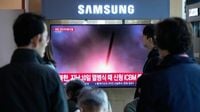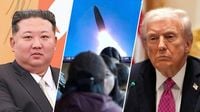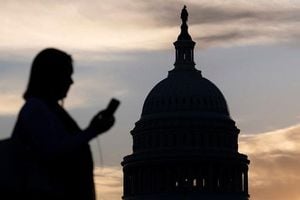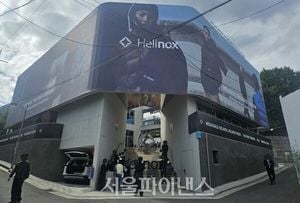North Korea has once again thrust itself into the global spotlight, firing multiple short-range ballistic missiles on Wednesday, October 22, 2025, just days before a high-profile gathering of world leaders in South Korea. According to multiple reports from Associated Press, Fox News, and Politico, the launches mark the country’s first ballistic missile tests in five months and come as U.S. President Donald Trump prepares for a diplomatic tour of Asia, culminating in the Asia-Pacific Economic Cooperation (APEC) summit in South Korea.
The South Korean Joint Chiefs of Staff detected the launches from an area south of Pyongyang, noting that the missiles traveled roughly 350 kilometers (about 220 miles) toward the northeast. The projectiles were said to have landed in the waters, though South Korea’s military did not provide further specifics. Despite the flurry of activity, none of the missiles landed in Japanese territorial waters, a fact confirmed by Japan’s Prime Minister Sanae Takaichi. She assured the press that, “Tokyo is closely communicating with Washington and Seoul, including by sharing real-time missile warning data.”
South Korea responded swiftly, convening a meeting of its national security council to assess the situation. The South’s military also emphasized its readiness to “repel any provocations by North Korea based on its solid military alliance with the United States,” as reported by Fox News. The launches have rattled nerves in the region, especially as they come ahead of a significant diplomatic event involving leaders from the U.S., China, Japan, and South Korea.
President Trump, in his first trip to Asia during his second term, is set to leave at the end of the week. His itinerary includes stops in Malaysia for a regional summit, then Japan, and finally South Korea for the APEC meeting scheduled from October 30 to November 1. Trump is also expected to visit the historic city of Gyeongju for bilateral meetings with Chinese President Xi Jinping and South Korean President Lee Jae Myung. However, South Korean officials have indicated that Trump may not attend the main APEC conference itself.
The timing of North Korea’s missile launches is hardly coincidental, say experts cited by Associated Press and Politico. Analysts have long suggested that Pyongyang could engage in provocative tests ahead of or during major international summits to underscore its demand for recognition as a nuclear weapons state. Such recognition, North Korean leader Kim Jong Un believes, is essential before he can push for the United Nations to lift the economic sanctions imposed over his country’s weapons program.
Wednesday’s launches are the first ballistic missile tests by North Korea since May 8, 2025, when the regime tested short-range systems simulating nuclear counterstrikes against U.S. and South Korean forces. The latest test is also notable as the first since South Korean President Lee Jae Myung took office in June. Lee campaigned on a platform of reducing hostilities and restoring peace on the Korean Peninsula. In his first address at the United Nations General Assembly last month, Lee spoke optimistically about “ushering in a new era of peaceful coexistence” and reiterated the need to pursue denuclearization while fostering inter-Korean cooperation, as reported by Deutsche Welle.
But the reality on the ground has been far more turbulent. Since the collapse of high-stakes nuclear diplomacy between Kim and Trump in 2019, North Korea has sharply accelerated its weapons testing program. In addition to Wednesday’s launches, Kim oversaw the testing of new air defense missiles in August, coinciding with joint U.S.-South Korea military exercises. These moves have been interpreted as both a show of strength and a signal of North Korea’s frustration with ongoing international pressure.
Last month, Kim hinted that he could return to talks if Washington dropped its longstanding demand for North Korea’s denuclearization—a demand Trump has repeatedly emphasized, even as he expressed hope for renewed diplomacy. “Kim suggested he could return to talks if the U.S. drops its demand for North Korea’s denuclearization, after Trump repeatedly expressed his hopes for new diplomacy,” noted Associated Press.
Adding further intrigue to the current standoff, Kim Jong Un recently showcased a new intercontinental ballistic missile (ICBM) at a massive military parade in Pyongyang. The parade, held on October 10 to mark the 80th anniversary of the founding of the Workers’ Party, was attended by a roster of foreign dignitaries, including Chinese Premier Li Qiang, former Russian President Dmitry Medvedev, and Vietnam’s Communist Party chief To Lam. North Korean state media described the new Hwasong-20 ICBM as the country’s “most powerful nuclear strategic weapon system.”
Observers believe the Hwasong-20 is designed to carry multiple nuclear warheads, with the explicit aim of defeating U.S. missile defenses. The missile has yet to be tested, but analysts warn that a test launch could occur in the coming months—a move that would likely escalate tensions even further. The military parade also featured an array of other missiles, including short-range, cruise, and supersonic models, underlining North Korea’s determination to build a diverse and formidable arsenal.
At the parade, Kim declared that the military “must continue to evolve into an invincible force that eliminates all threats.” The message was clear: North Korea intends to strengthen its position both regionally and globally, leveraging its growing military capabilities as bargaining chips in future diplomatic negotiations.
For its part, the international community remains wary. Japan’s government has maintained close communication with its allies, while South Korea has sought to reassure its citizens and partners of its military preparedness. The United States, meanwhile, faces the challenge of balancing deterrence with the possibility of renewed dialogue—a delicate act that has proven elusive for successive administrations.
As the APEC summit approaches, the question on everyone’s mind is whether North Korea will escalate its provocations or pivot toward diplomacy. With President Trump, President Xi, and President Lee all set to meet in the coming days, the stakes couldn’t be higher. The world watches, waiting to see if this latest round of missile tests will harden positions or open the door, however narrowly, to a new phase of engagement on the Korean Peninsula.
For now, North Korea’s message is unmistakable: it will not be sidelined, and its quest for recognition as a nuclear power remains at the forefront of its strategy.





